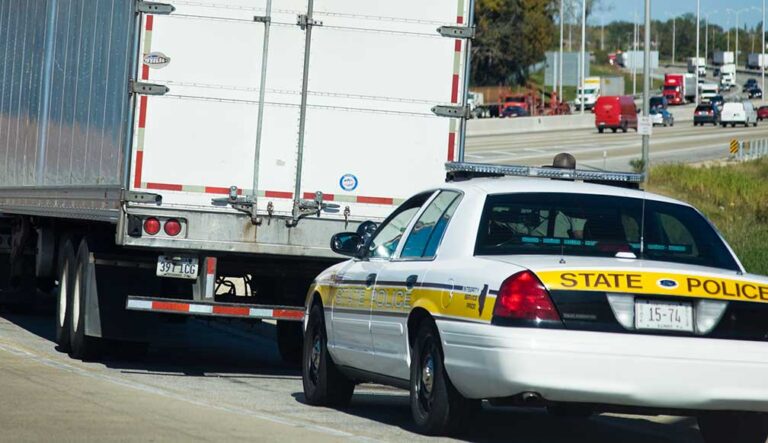We all know how much people love to hate lawyers. Even I can jump right on that bandwagon.
When you pay a lawyer for his/her advice, you’re often actually paying someone to be a killjoy. He/she will listen as you describe what you hope to accomplish — and then not-so-lovingly point out all the risks associated with your dreams.
“But with no risk, there are no rewards, Brad!” I can hear you saying. Well, that’s true, or at least partially true.
Mitigating every risk is impossible, but to avoid losing all those hard-earned rewards, minimizing your risk is a must. This is where your safety plan swoops in to save the day and keep those killjoys off your back.
A comprehensive safety plan starts with these five steps:
- Recruit driver candidates who value safety;
- Engage safety training both up-front and ongoing based on industry standards as well as both individual and fleet performance;
- Evaluate customer locations, freight and routes;
- Provide consistent communication with your drivers on Steps 1-3; and, if that’s not enough —
- Have a process in place for reducing the impact of mistakes when they are made.
I’m sure a parley with my friends in safety could drum up more, but most lawsuits could have been minimized or prevented through careful planning in these categories. And no, of course it’s not just about making money and preventing lawsuits (I know, it’s shocking to hear this from a lawyer), but it’s also about saving lives and feeling pride in how we take care of our people and our industry.
Let’s start with Step 1: Recruit driver candidates who value safety.
In addition to getting the driving history of your applicants, how are you evaluating their attitude about safety? If they have had accidents or tickets, are they taking accountability? Did they learn how to prevent it from happening again?
Here’s a good question to ask prospective drivers: “If you were faced with that same situation on the road again, what would you do differently?”
Perhaps they would pull over for bad weather, remove distractions, study their route more closely in advance, get out to look before backing, etc. Perhaps they’ll tell you there’s nothing they would do differently — which may tell you that, if they’re faced with this same situation at your company, they will likely have the same accident.
Discussing drivers’ previous tickets and accidents may also offer insight as to the attitude they would typically display at a traffic stop. The first guidance I give all drivers is this: Remain calm and professional and treat the officer with respect, regardless of whether you feel the stop was warranted or not, or if you feel the officer is reciprocating.
As you ask questions about a prospective driver’s MVR (motor vehicle record), notice their behavior. Are they becoming defensive with you? Angry? Accusatory?
When reviewing the dates of an applicant’s previous infractions, check to see if they have multiple tickets from the same incident/inspection. In my experience, more than one ticket (and especially more than two tickets) during one interaction means the driver put on his/her war uniform before interacting with the officer.
Also notice whether the driver is willing to take responsibility for his/her part in the interaction. For example, are they saying the citation was bumped up from speeding to reckless driving because the officer was “out to get them?”
Perhaps it’s worth asking a simple, direct question: “How was your interaction with the officer during this incident?” The response could be something like, “Oh he was an idiot. I only got those tickets because the cop was out to get me and wouldn’t listen to reason.” This type of attitude is likely to result in the driver putting several tickets on your fleet’s record — or possibly even the driver being arrested during a roadside interaction. (Meanwhile, you’ll be scrambling to recover your truck and deciding the best way to inform your customer you’re just a little behind schedule.)
Depending on the setup of your company, this conversation with a prospective driver might be with your recruiters, your safety team or your orientation supervisors. Whichever team takes on this conversation, make sure the person asking the questions is clear on the perspective you’re trying gain from an applicant’s responses to.
When it comes to screening and interviewing job candidates, it’s best to assign the duty to a small handful of very well-trained individuals. If, for the sake of expediency, you want to train your entire team to help speed the screening/hiring process, I recommend that you have team members conduct practice interviews with each other at least once a month to keep their skills fresh and focused.
You’re not going to mitigate every risk, but if you’re able to identify a hothead before you put him/her behind the wheel of a truck, you’re going to save your team a lot of headaches at the least — and explosive litigation at the worst.
Watch for Step 2 in the next Ask the Attorney column.
Brad Klepper is a regular contributor to The Trucker, providing valuable information for drivers and motor carriers. He is also president of Interstate Trucker Ltd., a law firm entirely dedicated to legal defense of the nation’s commercial drivers. Brad is also president of Driver’s Legal Plan, which allows member drivers access to his firm’s services at discounted rates.











